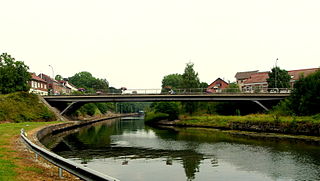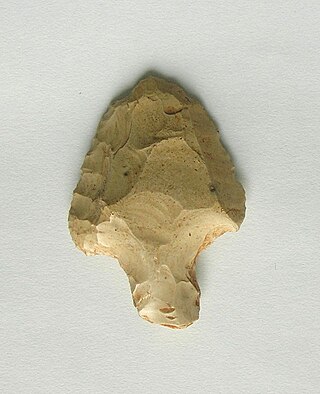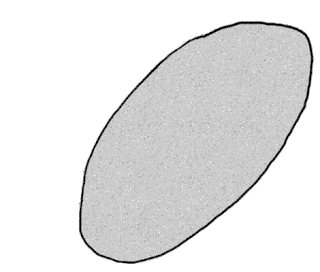
Lanaken is a municipality located in the Belgian province of Limburg. On January 1, 2007, the municipality of Lanaken had a total population of 24,724. Its area is 59.00 km² which gives a population density of 415 inhabitants per km².

Acheulean, from the French acheuléen after the type site of Saint-Acheul, is an archaeological industry of stone tool manufacture characterized by the distinctive oval and pear-shaped "hand axes" associated with Homo erectus and derived species such as Homo heidelbergensis.

The Creswellian is a British Upper Palaeolithic culture named after the type site of Creswell Crags in Derbyshire by Dorothy Garrod in 1926. It is also known as the British Late Magdalenian. According to Andreas Maier: "In current research, the Creswellian and Hamburgian are considered to be independent but closely related entities which are rooted in the Magdalenian." The Creswellian is dated between 13,000 and 11,800 BP and was followed by the most recent ice age, the Younger Dryas, when Britain was at times unoccupied by humans.

The Aterian is a Middle Stone Age stone tool industry centered in North Africa, from Mauritania to Egypt, but also possibly found in Oman and the Thar Desert. The earliest Aterian dates to c. 150,000 years ago, at the site of Ifri n'Ammar in Morocco. However, most of the early dates cluster around the beginning of the Last Interglacial, around 150,000 to 130,000 years ago, when the environment of North Africa began to ameliorate. The Aterian disappeared around 20,000 years ago.
The Middle Paleolithic is the second subdivision of the Paleolithic or Old Stone Age as it is understood in Europe, Africa and Asia. The term Middle Stone Age is used as an equivalent or a synonym for the Middle Paleolithic in African archeology. The Middle Paleolithic broadly spanned from 300,000 to 30,000 years ago. There are considerable dating differences between regions. The Middle Paleolithic was succeeded by the Upper Paleolithic subdivision which first began between 50,000 and 40,000 years ago. Pettit and White date the Early Middle Paleolithic in Great Britain to about 325,000 to 180,000 years ago, and the Late Middle Paleolithic as about 60,000 to 35,000 years ago. The Middle Paleolithic was in the geological Chibanian and Late Pleistocene ages.

The prepared-core technique is a means of producing stone tools by first preparing common stone cores into shapes that lend themselves to knapping off flakes that closely resemble the desired tool and require only minor touch-ups to be usable.

The Quina Mousterian is a variety of the Mousterian industry of the European Middle Palaeolithic, associated with Neanderthals and described by François Bordes. The Quina strategy emphasizes the production of thick and wide flakes, often bearing cortex, with the characteristic feature being scaled stepped retouch. The Quina Mousterian is usually dominated by transverse scrapers and typically has a Levallois index of less than 10%.

The South Asian Stone Age covers the Palaeolithic, Mesolithic and Neolithic periods in the Indian subcontinent. Evidence for the most ancient Homo sapiens in South Asia has been found in the cave sites of Cudappah of India, Batadombalena and Belilena in Sri Lanka. In Mehrgarh, in what is today western Pakistan, the Neolithic began c. 7000 BCE and lasted until 3300 BCE and the first beginnings of the Bronze Age. In South India, the Mesolithic lasted until 3000 BCE, and the Neolithic until 1400 BCE, followed by a Megalithic transitional period mostly skipping the Bronze Age. The Iron Age in India began roughly simultaneously in North and South India, around c. 1200 to 1000 BCE.

para-Methoxy-N-methylamphetamine, chemically known as methyl-MA, 4-methoxy-N-methylamphetamine, 4-MMA) or is a stimulant and psychedelic drug closely related to the amphetamine-class serotonergic drug para-methoxyamphetamine (PMA). PMMA is the 4-methoxy analog of methamphetamine. Little is known about the pharmacological properties, metabolism, and toxicity of PMMA; because of its structural similarity to PMA, which has known toxicity in humans, it is thought to have considerable potential to cause harmful side effects or death in overdose. In the early 2010s, a number of deaths in users of the drug MDMA were linked to misrepresented tablets and capsules of PMMA.
Patrick M.M.A. Bringmans was born 28 November 1970 in Hasselt, Belgium to Albert and Elly Bringmans-Jans. He is a Belgian archaeologist and paleoanthropologist whose main field of study has been the Palaeolithic period.
Fereidoun Biglari is an Iranian archaeologist and a museum curator.

Qal'eh Bozi is a complex of caves sites located about 25 km (15.5 mi) south-southwest of Isfahan, Iran; northeast of Dizicheh and north of Hassanabad. The sites include two rock shelters and a cave located at altitudes between 1,750 and 1,810 m above sea level. The caves are found on the southern face of a limestone mountain of lower Cretaceous age that rises to more than 500 m (1,640.4 ft) above the plain floor. From the cave entrance there is a commanding view of the plain below and of the Zaiandeh Rud River flowing about 2 km (1.2 mi) to the south and southeast.

Neanderthals, also written as Neandertals, are an extinct species or subspecies of archaic humans who lived in Eurasia until about 40,000 years ago. The type specimen, Neanderthal 1, was found in 1856 in the Neander Valley in present-day Germany.
Sabine Gaudzinski-Windheuser is a German archaeologist. She is a professor at the Johannes Gutenberg-University, Mainz and Director of the Monrepos Archaeological Research Centre and Museum for human behavioural Evolution of the Römisch-Germanisches Zentralmuseum at Monrepos Castle in Neuwied, Germany.

Hasmukh Dhirajlal Sankalia was an Indian Sanskrit scholar and archaeologist specialising in proto- and ancient Indian history. He is considered to have pioneered archaeological excavation techniques in India, with several significant discoveries from the prehistoric period to his credit. Sankalia received the Ranjitram Suvarna Chandrak award in 1966. And also received Padma Bhushan in the year 1974.

Monrepos is an archaeological research centre and a museum of human behavioural evolution located at Schloss Monrepos in Neuwied. The development of our modern human behaviour in the Palaeolithic and Mesolithic is studied at the research centre and the findings of these studies are conveyed to the public in the museum. Monrepos is one of the leading institutions for the research of early human history.

Roca dels Bous is an archaeological site located in Sant Llorenç de Montgai, in the Catalan Pyrenees, Spain. Since 1988 the Autonomous University of Barcelona and the UCL Institute of Archaeology study and record the fossil sequence of southern European Neanderthals who inhabited the area during the Middle Paleolithic approximately 50,000 years ago. The excavation team utilizes a worldwide unique digital system and various innovative technologies that significantly improve the quality of the classification of the recovered objects. Roca dels Bous has as one of the first Paleolithic excavation sites in Spain established a visitor centre, that focuses on displaying the Prehistory research of the prepyrenees area.

Theopetra Cave is a limestone cave located in Theopetra village of Meteora municipality, Thessaly, Greece. It is situated on the northeast side of a limestone rock formation that is 3 km (2 mi) south of Kalambaka. The site has become increasingly important as human presence is attributed to all periods of the Middle and Upper Paleolithic, the Mesolithic, Neolithic and beyond, bridging the Pleistocene with the Holocene.

Trou de l’Abîme also known as La caverne de l'Abîme and Couvin Cave is a karst cave located in Wallonia on the right bank of the Eau Noire river in the center of Couvin, Belgium, in Namur province. During various archaeological excavations of sediment deposits, Mousterian artefacts and a Neanderthal molar were discovered.














